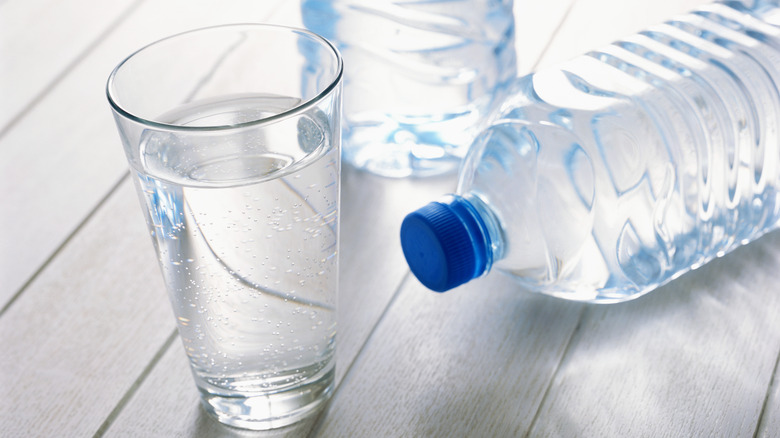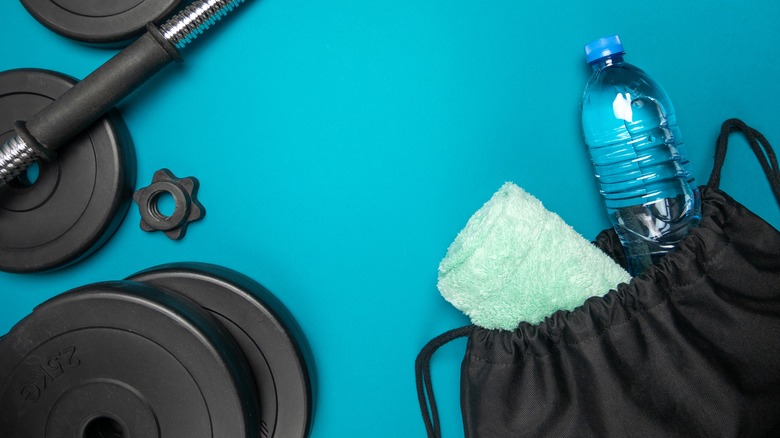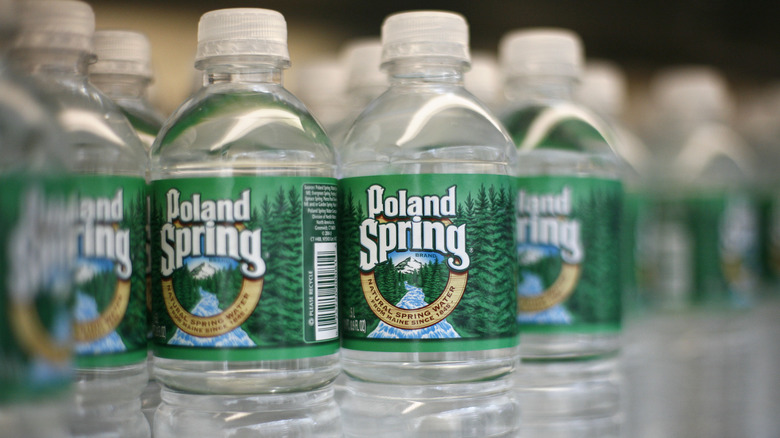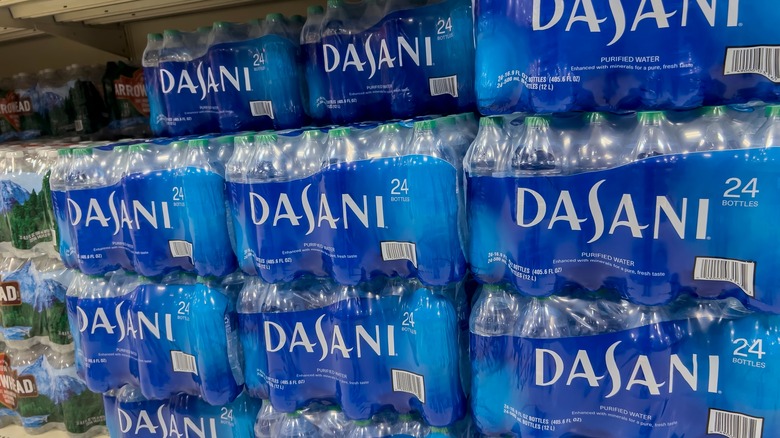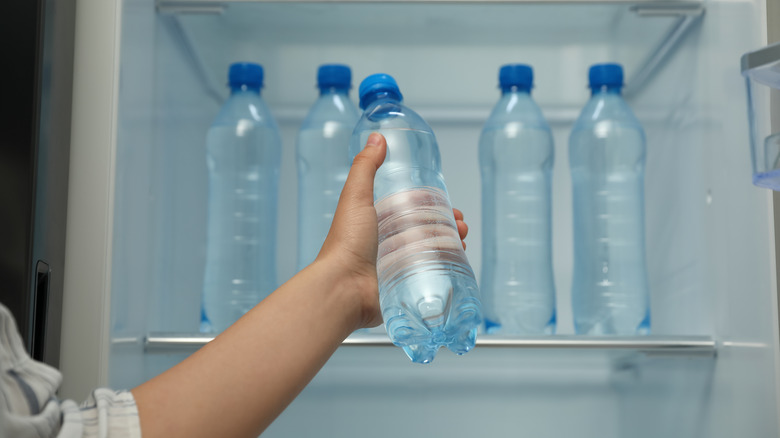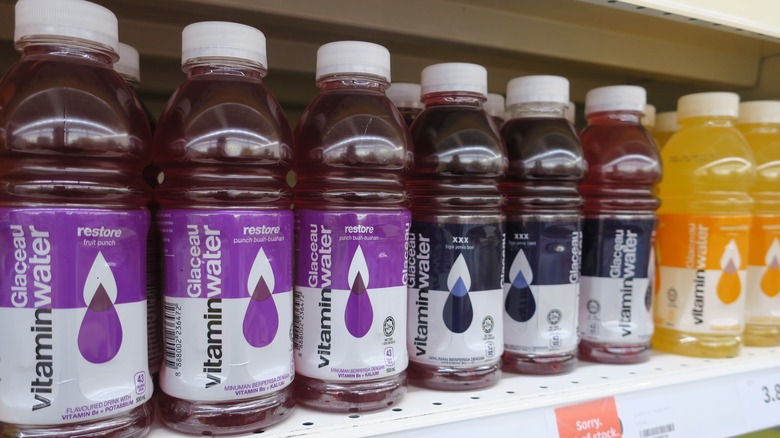The Promised Health Benefits That Helped Popularize Bottled Water
Are we taking the waters or getting taken by the waters? It's an interesting question. Especially, when it comes to our collective affinity for shelling out big bucks to quench our thirst with bottled water sourced from a "hidden" spring, or sip uber-expensive designer-brand H20 because it's better, purer, healthier — fill-in-the-adjective — than common tap water. Is it really, though?
Bottled water, or its equivalent, has been around for millennia. The International Water Association points to the strategic positioning of ancient settlements, usually built in the vicinity of a reliable water source — rivers, natural springs, wells — as a key factor in their survival.
Of course, they had to find a way to transport and store the water. The Nabateans, who settled in what is now Jordan, relied on clay pots (via Smart Water Magazine). An early version of bottled water? Maybe, but as far as we know, no one back then was hawking plain old water as a miracle elixir. That came later.
Bottle it and they will come
According to BCC Research, the bottled water we tote around in our gym bags today is the 21st-century incarnation of a practice that began in early 17th-century England when local entrepreneurs seized on the opportunity to sell take-home bottles of water sourced from England's holy wells — natural springs believed to have sacred powers — drawing the faithful from far and wide to collect, drink, and bathe in the healing water (via The Druid Way).
The holy springs — then and now — are particularly abundant in the Malvern Hills region of the British countryside where the water rises through an aquifer of Precambrian rock formations (via Malvern Spa Association). Farmers' Almanac reports that by 1622, enterprising residents realized they had an aqua-centric goldmine in their midst. So they did what any entrepreneurial community would do: They tapped into one of the primary springs and began selling to-go bottles of Holy Well Water, a portable elixir for whatever ails you. The brand thrived for centuries, eventually counting author Charles Dickens, anthropologist Charles Darwin, and even Queen Elizabeth II among its fans (via The Guardian).
Claims of a cure
The lore surrounding spring water attracted followers seeking miracle cures, and in some places prompted the establishment of site-specific destination spas designed for rest and relaxation in the form of water-based therapies (via BCC Research). In the United States, the phenomenon of bottled water took hold in the 1850s in the vicinity of a small inn operated by the Ricker family of Poland, Maine. The Rickers began selling water bottled from a spring on their property (via Serious Eats). According to Bottled Water Web, the spring water was initially touted as a kidney remedy that, according to family lore, miraculously cured a family patriarch who was reportedly on his deathbed.
Still, a substantial portion of bottled water's early customer base was made up of people who just thought it was a safer alternative to the early urban water supply. That all changed in 1905 when, according to Farmers' Almanac, British physician Alexander Houston successfully used chlorine to kill the bacteria responsible for the early-1900s typhoid epidemic, ultimately restoring trust in tap water and leading to a pretty good run until the mid-20th century. That's when the debut of lightweight plastic bottles upended the bottled water market, offering a cheaper, easily portable alternative to glass bottles. Game on. No longer constrained by source location, everyone wanted a piece of the bottled-water market. Not spring water — bottled water (via BCC Research).
Diluting the market
All of a sudden, major companies like PepsiCo and Coca-Cola were getting in on the action, introducing their own brands of purified water — filtered tap water like Aquafina and Dasani — into the mix (via BCC Research). While bottled spring water had historically been touted as a naturally pure alternative to municipal water, sourced from outlying springs far removed from urban centers, purified water was easier and cheaper to make. It didn't take long for purified water to grab hold of a hefty portion of the bottled water market.
According to the Beverage Marketing Corporation, bottled water surpassed carbonated soda to become the No. 1 beverage choice among Americans in 2016. In 2021, Pentair reported about 55% of bottled water sold in the United States meets the U.S. Food & Drug Administration's definition of spring water — meaning it's "derived from an underground formation from which water flows naturally to the surface, this water must be collected only at the spring or through a borehole that taps the underground formation feeding the spring." The remaining 45% consists mostly of tap water filtered through the process of reverse osmosis.
A funny thing happened
An interesting shift in consumer purchasing habits began to emerge early in the 21st century. For hundreds of years, people had selected spring water for its purported curative effects, then as an alternative to the potentially sketchy municipal water supply available by tap. When filtered water entered the market, consumers saw it as a good-enough substitute. And somewhere along the way, they just stopped caring. As Serious Eats reports, consumers realized there was very little difference between spring water and filtered water. According to Beverage Marketing Corporation, all bottled water is FDA-regulated and required to meet or exceed EPA public health standards for tap water.
Sure, purists could still argue the benefits of spring water. But glaring challenges like the 2017 class-action lawsuit claiming current-day Poland Spring Water contains "not one drop of spring water," (via Forbes) coupled with cracks in municipal water supply, like the Flint Water Crisis, had people turning to the best, cheapest alternative because, when it comes down to it, water tastes like water. To get ahead of the pack, bottled water, regardless of source, had to offer something extra. Like maybe, a health benefit.
Back to the future
Less than two centuries after the Rickers family began marketing water sourced from their spring in Poland, Maine as a health elixir, 21st-century bottled water companies jumped on the it's-good-for-you bandwagon and began marketing "enhanced" water in two categories — flavored and functional water (via Serious Eats). Flavored water is just that — bottled water kicked up a notch by adding fruit juice, herbs, and sometimes sweeteners.
Current-day functional bottled water is where we cross back in time to spring water's heyday as a remedy for whatever ails you. In grocery stores, they're sold as vitamin waters, enhanced with water-soluble vitamins and often sweetened with sugar (via Men's Health). The market also boasts protein waters, containing whey protein isolate and collagen peptides (via Healthline), and energy waters blended with caffeine and sugar (via Everyday Health). Are they good for you? Do they deliver on their promises? According to Time, the health community isn't sold on the purported benefits. And Serious Eats reminds us that descriptors like energy water and vitamin water are marketing terms, not official FDA terminology.
